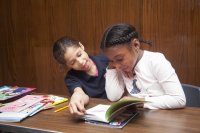3 Ways to Make Better Use of Reading Science
Teaching reading is hard. But there are fundamental things we know about how kids learn to read—the key is to remain nuanced in their application.
Your content has been saved!
Go to My Saved Content.The “reading wars” of the early aughts pitted advocates of phonics-based instruction against whole language supporters—and both sides claimed to have science on their side. The contours of the argument are reasonably well known by this point, writes Benjamin Riley for ASCD.
On the one hand, supporters of phonics-based instruction, leveraging findings from a National Reading Panel report published in 2000, argued for the importance of developing phonological awareness in young readers—we are not hardwired to read in the way we are to speak, the panel concluded, and explicit instruction on how letters and their corresponding sounds map to meaning is required to master the craft.
Advocates of a whole-language approach, on the other hand, de-emphasized phonics in favor of more “natural” reading strategies focused on seeking out “context cues” to make meaning of texts. As new science on reading emerged, the “whole-language supporters largely shifted to supporting ‘balanced literacy,’ which, to summarize briefly, ostensibly blends phonics and other reading-skills instruction with time for children to read complete texts,” Riley says.
While the reading experts eventually called a truce, educators and policy makers are once again exploring how best to apply the principles of reading-science in the classroom. The good news, writes Riley, is that there are plenty of areas of agreement among scientists and researchers who study reading.
We know that explicit phonics instruction is a critical early tool for decoding text, and that children benefit from it, Riley insists. But we also know that reading doesn't end with the simple act of decoding—the research suggests that "the key factor in helping young children transition from decoding text to becoming fluent readers is lots of reading practice with varied texts," though direct instruction should not be fully replaced by independent reading. Finally, reading doesn’t occur in a vacuum. Strategies designed to develop comprehension skills more generally cannot “compensate for lack of vocabulary or content knowledge on a particular subject,” in the words of cognitive scientist Daniel Willingham, a professor of psychology at the University of Virginia.
The big picture? With renewed interest about the science of reading—”educators at all levels, from university faculty to early childhood-education teachers, are clamoring to learn more”—Riley suggests that there is a middle path. He outlines three principles he hopes “reading science enthusiasts” will use to advance an understanding of the science of reading:
Don’t Believe the Hype
Nuance—not inflexible commitment to an ideology—is the key when it comes to using effective, thoughtful pedagogical practices culled from reading science, writes Riley. “Yes, there is strong scientific consensus that supports the use of phonics in the early stages of learning to read. But it is equally true, scientifically, that ‘reading comprehension clearly entails more than identification of individual words: Children are not literate if they cannot understand text’,” he writes. “Learning to read is a progression from decoding text to fluent reading to deeper inference and comprehension. In advocating for reading science, we should recognize this nuanced progression rather than fall into the trap of stridently demanding (on its own) ‘more explicit phonics instruction’.”
Take Control of the Science
While reading science may show us how, from a cognitive perspective, our minds make sense of written symbols—in other words, how we develop as readers—teachers still need to figure out the best pedagogical approach to use for their students. It’s not one size fits all, and the needs of a particular student may demand that you slow down, speed up, or pursue a different tack. “Scientific insights should inform education practice by adding to a teacher’s mental model of how their students make meaning of text,” says Riley. “That still leaves a great deal of space for educators to decide which pedagogical techniques they’ll use to help students learn to read.”
Celebrate Progress—and Stop With the Shaming
Though teacher prep programs are often criticized for turning out poorly-prepared teachers, Riley notes that a growing number of programs are working to improve their practice. Five schools of education in North Carolina, for example, are exploring ways to integrate reading-science principles into coursework and practical training for teacher candidates. “It’s time to move past stereotypical critiques and the strategy of shame, and instead offer support and encouragement to those who are helping to grow this movement,” he writes.
